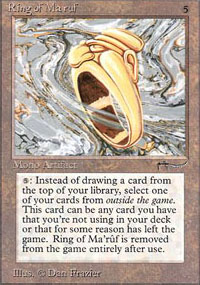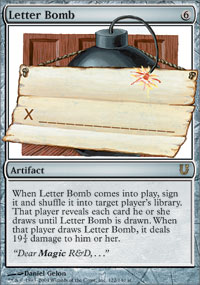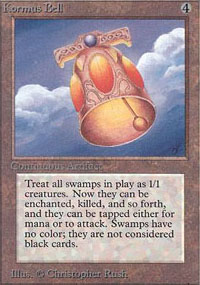
Cranial Insertion
The E-Postman Always Dings Twice
By Eli Shiffrin, Tom Fowler, and Diane Colley

But Ma'ruf only rings once.
Last week, we did a single-topic article on the layer system. We do those articles occasionally, covering areas of the rules that are sticky and/or interesting. If you have a request for a future single-topic article on just such an area of the rules, leave your comment in the article thread, or email it to us at [email]cranial.insertion@gmail.com[/email]. That’s also where you can send us your questions, of course.
In other column news, congratulations to Urchin, who has joined the ranks of Level 3 judges! Yay Urchin!
We have a full mailbox this week, so let’s empty it out.
Q: Recently, you answered a question about Skizzik, its kicker, Cytoshape, and Grizzly Bears. Does this mean that if I have another creature whose kicker cost was paid, and that is then made into a copy of Skizzik, it doesn't need to be sacrificed?
A: Skizzik has a specific kicker cost. When an object wants to know if its kicker cost was paid, that means, “the kicker cost native to the same object as this ability.” For Skizzik, that means the kicker of
We're hoping this will be made clearer in the Eventide Comp Rules update.
Q: I attack and deal combat damage with Hypnotic Specter and Hollow Specter. I place the triggers such that Hypnotic Specter is the first to resolve. Do I pay for Hollow Specter's ability when the ability resolves, or when the ability is placed on the stack?
A: Triggered abilities never have a cost to pay as they’re put onto the stack. Any cost associated with a trigger will be paid when it resolves. Compare this to Lightning Rift and Decree of Justice: just like with Hollow Specter, you had the option to pay the mana required as the ability resolved.
Bonus: Any targets required by the trigger must be chosen when you put it onto the stack.
Q: After damage is placed on the stack, can an attacking face-down Chromeshell Crab be turn up to exchange control with the blocking creature and damage still be dealt to each creature?
A: Those crafty crustaceans! Sure, this works.
310.4a Combat damage is dealt as it was originally assigned even if the creature dealing damage is no longer in play, its power has changed, or the creature receiving damage has left combat.
As we can see, combat damage will be dealt as assigned, even if the creatures involved swap sides. That does remove them from combat, but doesn’t get them out of the damage that’s coming at them. The likely result is that you’ll control the surviving creature, and your opponent will briefly control a dead Chromeshell Crab. It appears that dead crabs are good for more than just being steamed and served with Old Bay and beer.
Q: If my planeswalker is being attacked can I play Vindicate and Reknit on it to remove it from combat and prevent it from being attacked?
A: Presuming you have a way to play Vindicate as an instant, yes. Usually, we’re only concerned about creatures regenerating and being removed from combat, but the same thing applies to planeswalkers, too. A permanent that regenerates (that is, uses a regeneration shield, not simply has one created) is removed from combat.
419.6b Regeneration is a destruction-replacement effect. The word “instead” doesn’t appear on the card but is implicit in the definition of regeneration. “Regenerate [permanent]” means “The next time [permanent] would be destroyed this turn, instead remove all damage from it, tap it, and (if it’s in combat) remove it from combat.” Abilities that trigger from damage being dealt still trigger even if the permanent regenerates.

Please do not bomb us.
We come in peace.
Not pieces.
A: One-sided exchanges only happen when you’re trading away Kevin Garnett or Pau Gasol. In Magic, you have to give up something to get something. That means both objects being exchanged must actually be exchanged. If, for some reason, one of them can’t, then the entire trade is off. Note that the Puca’s Mischief ability will resolve, since it still has one legal target, but it just won’t do anything since it can’t make a legal exchange.
Q: I play Replenish and have a Daybreak Coronet in my graveyard, but no enchanted creatures in play. Can I put the Coronet into play if it comes into play along with another enchantment, or is it unable to choose a target when I play it?
A: Enchantments being Replenished back into play don’t target. However, you have to choose an object they can legally enchant, if possible. You make these choices for the auras before any of them are returned to play, so if there are no creatures in play that are already enchanted, the Coronet can’t be attached to them, so it can’t return to play. It will remain in the graveyard.
Bonus: If your opponent happened to control the only enchanted creature, guess where your Coronet would go?
Q: I play Farhaven Elf. Can I be a total pimp and go search for a Murmuring Bosk and put it into play because it’s a Forest?
A: It’s hard out here for a pimp. One of the things making it hard is that you can’t fetch Murmuring Bosk with Farhaven Elf. While Murmuring Bosk does have a basic land type, it doesn’t have the supertype “basic,” and those are the only lands you can find with Farhaven Elf.
Compare Farhaven Elf, which instructs you to get a basic land, with Wood Elves, which instructs you to get a Forest. Wood Elves would allow you to fetch Murmuring Bosk, since the Elves only care that the land you get has the Forest subtype.
Q: Player A has an Inkfathom Witch with two Helms of the Ghastlord attached to it. He attacks and his opponent doesn't block. Player A activates the Witch’s ability and player B deals 1 damage to the Witch with Power of Fire. Player A says that his Witch is an 8/5 and player B says the Witch is a 4/1. Who is right?
A: Player A is right. Let’s use some of the spiffy layering knowledge we learned last week and figure out why.
6a: CDAs – Nothing.
6b: Catch-all – Witch becomes 4/1.
6c: Counters – Nothing.
6d: Static +/- – Two Helms add +2/+2 each; Witch is 8/5.
6e: Switching – Nothing.
The Witch becomes a 4/1 in layer 6b, then becomes an 8/5 when the bonuses from the Helms are applied in layer 6d.
Q: If I destroy an Everlasting Torment with Molder, do I get to gain any life?
A: You will. This is because you carry out the effects of Molder in the order they’re printed on the card. First, you destroy Everlasting Torment. Normally, its maniacal, distracting laugh prevents players from gaining any life. When it’s in the graveyard, though, the laugh is just a tinny snicker, and you can ignore it and gain life again. So then you follow that instruction and gain 3 life—since Everlasting Torment isn’t in play, it can’t modify the life-gaining event. Then Molder goes to the graveyard. And Scully weeps.
Bonus: Yes, I know it’s spelled “Mulder.” Leave me to my lousy puns.
Q: If Darien, King of Kjeldor is targeted with Lash Out and Lash Out's controller wins the clash, three 1/1 creature tokens are put into play, correct?
I’m guessing it is, because of rule 408.1f that states that triggers wait to be put onto the stack until the currently resolving spell or ability has finished resolving, correct?
A: Yup. Basically, what 408.1f is saying is that once Darien’s ability triggers, it will be put on the stack when it’s appropriate to do so, regardless of whether Darien is still in play at the time.
Q: If Darien, King of Kjeldor is destroyed by Kaervek's Purge or Cinder Cloud and damage is dealt to Darien, King of Kjeldor's controller, no creature tokens are produced, correct?
This is because destruction of a permanent during the resolution of a spell or ability causes it to go to its owner's graveyard immediately, correct?
A: Yes. This is like the Molder + Everlasting Torment question above. You follow the instructions in the order written. First, the creature is destroyed. This isn’t an SBE (like Darien taking lethal damage in the question above), and it happens immediately when instructed. Then damage happens, but Darien is already in the graveyard, so his ability will never trigger.
Bonus: Here’s another example, which those of you playing during the Mirrodin era may remember. Let’s say you have 2 Disciples of the Vault and 4 Myr Enforcers in play. I play an entwined Solar Tide. We follow the instructions in order. First, destroy all creatures with power 2 or less. Bye-bye, Disciples. Then, destroy all creatures with power 3 or greater. There go the Myr Enforcers. Now, if this had been Wrath of God, I’d be sucking up the loss of 8 life. Instead, the Disciples were destroyed first, so they weren’t in play to trigger when the Myr Enforcers were destroyed a moment later.
Q: Murderous Redcap with no counters vs. Yamabushi's Flame: does the Redcap come back via Persist?
A: Nope. The flames of a yamabushi are more persistent than a goblin. Persist triggers when the creature is put into the graveyard from play. Yamabushi’s Flame, however, banishes it to the RFG zone right away. Do not pass
Q: I am aware that regeneration stops the creature from being destroyed, but does it actually prevent damage?
A: No, it doesn’t. Regeneration removes damage on the permanent. This is much different than preventing damage.
Q: If I equip my creature with a Bonesplitter and my opponent takes control of it, does the Bonesplitter stay attached and can I still use its equip ability?
A: At the risk of sounding Clintonian, that depends on what you mean by “it.” If you mean your opponent took control of the creature, then the Bonesplitter stays attached. However, you still control the equipment, so only you can play its equip ability. If your opponent gained control of the Bonesplitter, it remains attached, but he will be the one who can play the equip ability.

Now they can be enchanted,
killed, and so forth!
A: He is. The reason is that, with the modes you chose for Primal Command, you played a spell that had a single target: the land you wanted to put atop your opponent’s library. If a spell has a single target, and that target is illegal or invalid when the spell tries to resolve, then it’s countered. None of its other effects happen. In this case, Primal Command was countered because the targeted land was no longer in play when it tried to resolve, so none of its effects happen. And that means you don’t get to search for a creature.
Q: If I control a Rosheen Meanderer and someone tries to counter one of my spells with Broken Ambitions, can I use mana from Rosheen to pay for it?
Or in other words, what exactly constitutes a cost?
A: Here is the definition of “cost” from the CR glossary:
Cost
A cost is an action or payment necessary to take another action or to stop another action from taking place.
Playing spells and activated abilities requires paying a cost. Most costs are paid in mana, but costs may also include paying life, tapping or sacrificing permanents, discarding cards, and so on.
A player can’t pay a cost unless he or she has the necessary resources to pay it fully. For example, a player with only 1 life can’t pay a cost of 2 life, and a permanent that’s already tapped can’t be tapped to pay a cost. See rule 424, “Costs,” rule 203, “Mana Cost and Color,” and rule 403, “Activated Abilities.”
Some spells and abilities have no cost. In such instances, the cost can’t be paid.
Basically, a cost is anything that the game or an effect demands to be paid. Anytime X appears as a mana symbol (on cards as , or in Oracle text as {X} or oX or {oX}), it’s a cost. Broken Ambitions is telling you to pay . That means Rosheen Meanderer will happily contribute
Q: When a card specifies "do X as long as ~ remains tapped," what happens if the card is change into another card and then untaps?
Example: A player controls both Giant Oyster and Cemetery Puca (copying Giant Oyster) and both tap down creatures A and B, respectively. Cemetery Puca changes into a different creature. During the untap step, Cemetery Puca untaps and its controller decides to leave Giant Oyster tapped. Is creature B freed from the "does not untap during its controller's untap step" effect?
A: An effect like you describe is typically generated by a triggered or activated ability. The resulting ability is independent of its source, and will look at that source (regardless if its name has changed) to figure out if its duration continues or has ended. Since Giant Oyster’s ability contains “as long as ~ is tapped,” and it’s an effect from an activated ability, the duration will continue as long as the object is in play and tapped, even if it’s no longer recognizable as a Giant Oyster.
A more common case is Vesuvan Shapeshifter copying Sower of Temptation. Even if the Shapeshifter copies another creature, as long as it remains in play, you’ll keep the creature it stole when it was a Sower. It’s the same object, even if its name (and some other characteristics) have changed.
In the Oyster case, the Oyster-Puca-Whatever has untapped, so the effect’s duration has ended. Creature B will be able to untap when the time comes.
Q: How come a Dread destroyed while Humility is in play will be reshuffled, but a persist creature, like Gravelgill Axeshark, destroyed while Humility is in play doesn’t come back?
A: The difference is in the wording of their triggered abilities. Specifically, “when ~ is put into a graveyard from anywhere” vs. “when ~ is put into a graveyard from play.”
410.10d Normally, objects that exist immediately after an event are checked to see if the event matched any trigger conditions. Continuous effects that exist at that time are used to determine what the trigger conditions are and what the objects involved in the event look like. However, some triggered abilities must be treated specially because the object with the ability may no longer be in play, may have moved to a hand or library, or may no longer be controlled by the appropriate player. The game has to “look back in time” to determine if these abilities trigger. Abilities that trigger specifically when an object leaves play, when an object is put into a hand or library from a public zone, or when a player loses control of an object will trigger based on their existence, and the appearance of objects, prior to the event rather than afterward.
Emphasis added. Abilities that trigger specifically on the object leaving play have to “look back in time” to right before it left play. At that time, Humility has removed any abilities the creature might have, so persist will not trigger. Dread, however, has a “from anywhere” clause on its trigger. Since that isn’t specifically a leaves-play trigger, the game looks at it after the event rather than before it. Dread in the graveyard is free from the effects of Humility, so its ability will trigger and it will be shuffled back into its owners library.
That’s all we have for this edition of CI.
Next week: Questions from Regionals, as well as the mailbag.
-Tom Fowler
Comments